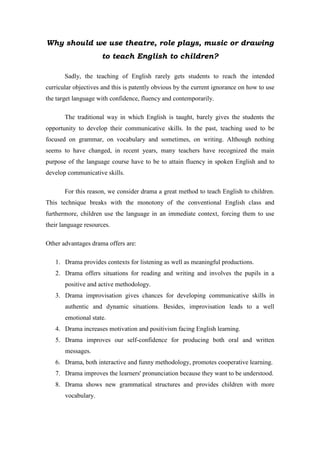
Drama
- 1. Why should we use theatre, role plays, music or drawing to teach English to children? Sadly, the teaching of English rarely gets students to reach the intended curricular objectives and this is patently obvious by the current ignorance on how to use the target language with confidence, fluency and contemporarily. The traditional way in which English is taught, barely gives the students the opportunity to develop their communicative skills. In the past, teaching used to be focused on grammar, on vocabulary and sometimes, on writing. Although nothing seems to have changed, in recent years, many teachers have recognized the main purpose of the language course have to be to attain fluency in spoken English and to develop communicative skills. For this reason, we consider drama a great method to teach English to children. This technique breaks with the monotony of the conventional English class and furthermore, children use the language in an immediate context, forcing them to use their language resources. Other advantages drama offers are: 1. Drama provides contexts for listening as well as meaningful productions. 2. Drama offers situations for reading and writing and involves the pupils in a positive and active methodology. 3. Drama improvisation gives chances for developing communicative skills in authentic and dynamic situations. Besides, improvisation leads to a well emotional state. 4. Drama increases motivation and positivism facing English learning. 5. Drama improves our self-confidence for producing both oral and written messages. 6. Drama, both interactive and funny methodology, promotes cooperative learning. 7. Drama improves the learners' pronunciation because they want to be understood. 8. Drama shows new grammatical structures and provides children with more vocabulary.
- 2. 9. Drama leads the imagination to the divergent thinking and provides the students chances to create new stories and dialogues. Quotes: "In terms of improved communication skills, creativity, increased social awareness, independent thinking, verbalization of opinions, development of values and appreciation of the art of drama" (Furness, 1976). "Role playing helps the individual to become more flexible" and "develop a sense of mastery in many situations". "Through role play, L2 learners can experience many kinds of situations in which they will use the language; and as they develop a sense of mastery in them, they should be able to apply the language more easily to new situations” (Stern, 1983). "Role play is one of a whole gamut of communicative techniques which develops fluency in language students, which promotes interaction in the classroom, and which increases motivation” (Ladousse, 2004). Is there any book which explains specific techniques? 1. The choice of the topic The topic of the activity can be chosen by the students or by the teacher. The advantage of letting pupils choose it is the conviction it will have interest for them. However, most teachers prefer using another technique which consists in offering some topics to the pupils and allowing them to vote for one. 2. The creation of the dialogues In order to create the dialogues, firstly, the teacher needs to look at proper situations and plays according to the level of the learners. After that, he decides whether he will provide the students with the dialogues or if he will give them freedom to create or modify other new ones. It depends on the cognitive demands required by the learners. In this case, learning will be more
- 3. significant due to learning by doing and collaborating brings out a higher motivation, confidence and positivism. 3. Role playing Before acting, students can practise the play with their classmates in pairs or in groups in order to put aside their embarrasment. Besides, working cooperatively offers the possibility to choose the role closer to the preferences. This is called "exchanging the roles". Finally, the play is represented when the students consider they are prepared enough. 4. Assessment a. Pupils’ assessment Pupils should be continuously assessed. Getting a high level in drama is truly difficult so we have to be aware of this and evaluate each student’s progress, not only the final result. In this sense, learners’ interaction and learners’ participation are an essential part in drama activities as well as their starting points. It is the responsibility of the teacher to provide them with appropriate tools to take part in the progress of teaching-learning. An effective method may be to correct the errors after the play; otherwise we might discourage children in future activities. Ultimately, the teacher would like everybody to improve the fluency in spoken English and develops skills to communicate with foreign people. b. Teachers’ assessment The teacher has to evaluate the development of the activity and he also should evaluate his own work, because it is likely not all the activities work as he had expected. For this, he could wonder some questions such as: Do the activities help to develop communicative skills? Is the activity interesting for the pupils?
- 4. Are the students motivated? Is the grammar accessible? Have I considered which language is needed to carry out the activity? Have I considered how to deal with diversity? Have I thought about what I might change in the activity? How can we use this general activity to teach English to children? Can you mention some specific bibliography or websites where you can find more information about this question? References http://iteslj.org/Articles/Boudreault-Drama.html http://iteslj.org/Techniques/Chauhan-Drama.html